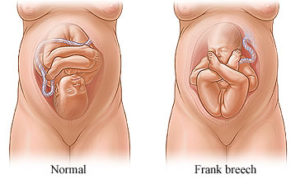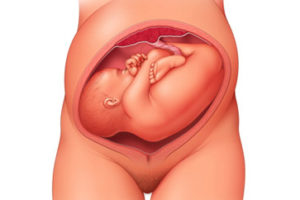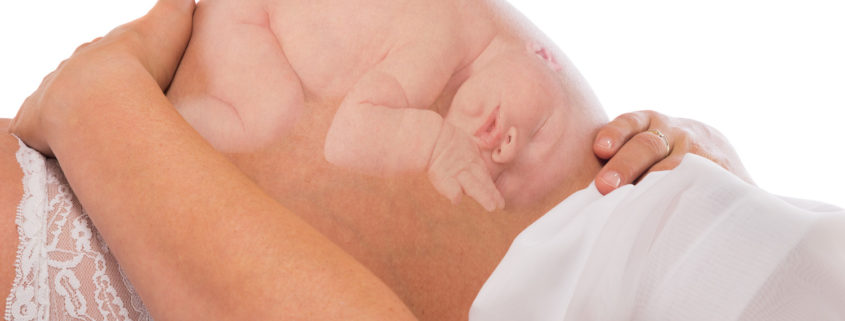Different Positions of a Baby in the Womb
Unborn babies toss and turn and hold many different positions within the womb during the gestation period; pregnant women everywhere will attest to the fact that their children always start up the gymnastics at bedtime. When the due date nears, the importance of the baby’s position becomes less of a joke and a serious point of discussion. The different positions that your baby may take in the womb will play a role in how he is born.
Head-Down
Most babies flip and turn with great frequency throughout pregnancy but generally end up in the “head-down” position around the 33 to 36-week range, according to the American Pregnancy Association. Head-down literally means that the baby’s head is pointing toward the birth canal, and his feet, when his legs are fully extended, are in the vicinity of his mother’s ribs. Babies at this advanced gestational age most commonly stay in the head-down position for the remainder of the pregnancy and may not move as much as in the earlier months, mainly due to space constraints.
Breech 
Breech is the position in which the baby’s buttocks or feet are nearest to the birth canal. A breech baby’s head is close to her mother’s ribs. This position is less desirable than the head-down position for birth, and breech babies have an increased risk of birth defects or trauma during the birth. Your doctor may try to turn the baby around in a procedure called a version, deliver the baby in a breech position or perform a cesarean section. Abnormalities in the baby’s anatomy or the shape of your uterus may prevent the baby from turning around.
There are three variations of a breech presentation:
- Complete breech: When the buttocks are pointing toward the birth canal (downward), with the legs folded at the knees. The feet are near the buttocks.
- Frank breech: The buttocks are toward the birth canal, but the baby’s legs are straight up in front of their body and the feet are near the head.
- Footling breech: One or both of the baby’s feet are pointing downward toward the birth canal.
Transverse
 A baby that lies sideways in his mother’s womb is in a horizontal position. The baby’s head may point to the left side of your body and the feet to the right, or vice versa. Transverse positioning at the time of birth is extremely rare; only one out of 2,000 babies takes a transverse position. Like breech presentation, a baby who lies sideways may not be able to turn around due to structural abnormalities in the uterus. Pregnancy Today explains that babies who are transverse are delivered by cesarean section to ensure a safer delivery.
A baby that lies sideways in his mother’s womb is in a horizontal position. The baby’s head may point to the left side of your body and the feet to the right, or vice versa. Transverse positioning at the time of birth is extremely rare; only one out of 2,000 babies takes a transverse position. Like breech presentation, a baby who lies sideways may not be able to turn around due to structural abnormalities in the uterus. Pregnancy Today explains that babies who are transverse are delivered by cesarean section to ensure a safer delivery.
Risk Factors for Transverse Lie
Women with the following conditions are at a high risk for transverse presentation:
- A high ratio of amniotic fluid to a fetus
- Uterine abnormality
- Placenta previa
- Fibroids in the uterus
- Factors preventing fetal head engagement in the mother’s pelvis
- Narrow or contracted pelvis
- More than 2 babies in the womb
Diagnosis of Transverse Presentation
Abdominal examination— In transverse position, the presenting part of the fetus is typically the shoulder. During an abdominal examination, the head or the buttocks cannot be felt at the bottom of the uterus and the head is usually felt on the side.
Vaginal examination— A shoulder may be felt during a vaginal examination. An arm of the fetus may even slip forward and the hand or elbow may be felt during the pelvic examination.
Confirmation – An ultrasound scan of the uterus confirms the transverse lie position.
Complications of Transverse Lie
A transverse presentation can cause serious complications during delivery. Some of the consequences are listed below:
- Obstructed labor
- Umbilical cord or hand prolapse
- Postpartum hemorrhage
- Birth trauma
- Rupture of the uterus
Posterior
Babies in the head-down position most often enter the world with their faces facing their mothers’ backs. Posterior is the term used to describe a baby in the head-down position with her face facing the mother’s stomach, in other words with her face turned up. The altered positioning of the baby’s body may lead to back labor in the mother, rather than cramping in the abdomen.
Can I turn my baby?
Occasionally, a baby may not end up in the correct position for delivery. It’s important to know if your baby isn’t in the occipito-anterior position right before birth. Depending on the exact position, it could lead to complications during delivery. There are some methods you can use to coax your baby into the right position.
You can try the following ideas:
- When you sit down, tilt your pelvis forward instead of backward.
- Spend time sitting on a birth ball/exercise ball.
- Make sure your hips are always higher than your knees when you sit.
- If your job requires lots of sitting, take regular breaks to move around.
- In your car, sit on a cushion in order to lift up and tilt your bottom forward.
- Get on your hands and knees (like you are scrubbing the floor) for a few minutes at a time. Try this a few times a day to help move your baby into the anterior position.
Unfortunately, these tips don’t always work. If your baby stays in a posterior position when labor starts, it may be because of the shape of your pelvis rather than your posture. In some cases, a cesarean delivery will be necessary.
Resources:
https://www.healthline.com/health/pregnancy/baby-positions-in-womb#turning-baby
https://www.livestrong.com/article/204490-different-positions-of-a-baby-in-the-womb/




Leave a Reply
Want to join the discussion?Feel free to contribute!